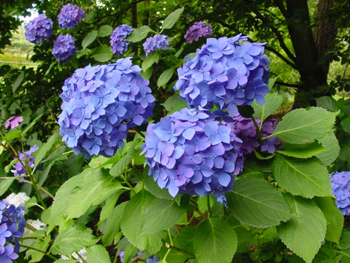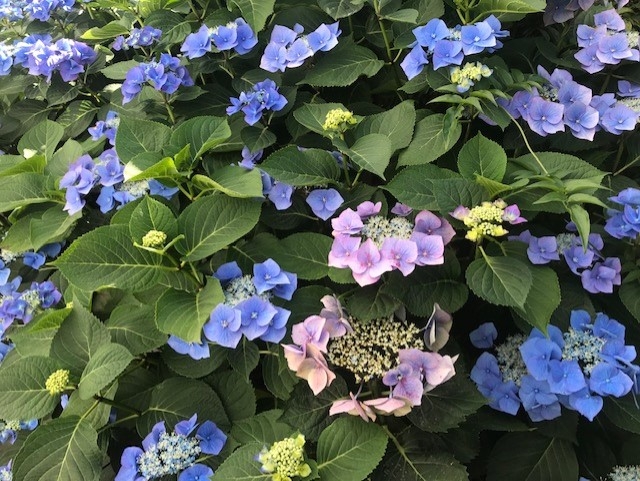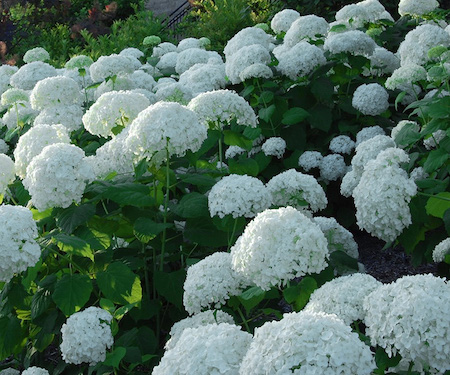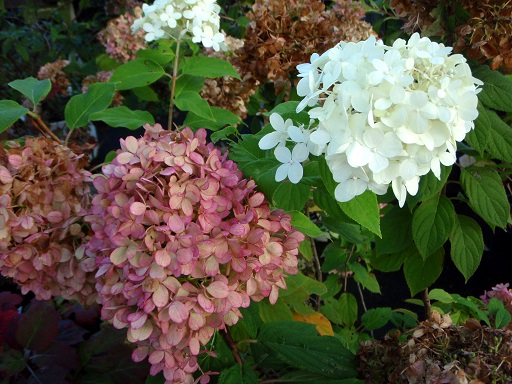Hydrangeas: The Basic Types
by Elaine Homstad, Fairfax Master Gardener

Hydrangea macrophylla
Hydrangeas have been an important part of landscapes for centuries. First introduced to Europe and North America in the 1730s, gardeners appreciate them for their easy care and their long-lasting flowering season.
There are about 70 different species of hydrangeas, but only six that are commonly cultivated. Most originated in the far east Asian countries such as China, Korea and Japan, but two species are natives to the eastern United States.
Their versatility is highlighted by the range of the planting zones in which they can survive. Depending on the species, they can be grown in Zones 3 through 9, meaning that they can be grown in SOME part of EVERY U.S. state.
Basic Needs
All hydrangeas share certain basic needs and are easy to grow in our Zone 7 climate here in Fairfax County. They like soil rich in organic matter, regular moisture and protection from the strong western afternoon sun. Here are some tips to help you grow hydrangeas successfully in this region:
- Hydrangeas thrive in rich, organic soil. Amending the soil with compost or other organic matter can improve its texture and fertility and help the plants establish strong roots and promote healthy growth.
- Hydrangeas need regular moisture to thrive. Some tolerate drought better than others but try to keep a consistent moisture level throughout the season, through mulching and supplemental watering during dry spells.
- Most hydrangeas prefer morning sun and afternoon shade. Planting them on the north or east/southeast side of your home helps to protect them from intense afternoon heat. If that isn’t possible, learn which varieties can tolerate more sun and be prepared to provide supplemental moisture. For all varieties, fewer than two hours of sunlight will result in fewer flowers.
- Hydrangeas benefit from regular feeding. Providing natural soil amendments or using a balanced, extended-release, commercially available fertilizer are options. Be careful not to over-fertilize, as this can lead to excessive leaf growth at the expense of flowers.
Types of Hydrangeas
Hydrangeas are mainly characterized by the size and shape of their blooms. There are three different types of flowers: mophead (large globe or dome-shaped flower heads); lacecap (a flattened head of small flowers surrounded by larger flowers); and panicle (cone or pyramidal-shaped flower heads).
• Hydrangea macrophylla or bigleaf hydrangea

Hydrangea Macrophylla Lacecap
This species has the largest number of varieties (over 500) of all hydrangeas, thus making it the one that appears most frequently. Most can do well in Zones 6 to 9, with some hardy to Zones 3 to 5 with winter protection. They can grow from 3 to 8 feet (1 to 2.5 m) tall and wide, depending on the cultivar. They prefer morning sun and afternoon shade, and bloom from June to October in shades of white, blue, pink, purple and red. Their blooms can be either the mophead or lacecap style. The color of the blooms may be influenced by the soil’s pH, with blues and purples appearing in low pH (acid) soil and darker pinks and reds present in higher pH (alkaline) soil. Some cultivars are also bred to remain a specific color or colors, regardless of pH levels. They generally need little pruning, just some tidying up as spring growth begins, or to control their size.
• Hydrangea arborescens or smooth hydrangea

Hydrangea arborescens
These hydrangeas, native to the southeast U.S., can grow in Zones 3 to 9. They are very hardy and can survive even an extremely harsh winter. Growing to about a 5 foot height (1.5 m) and width, and with only about 15 cultivars, they bloom from June to September, mostly on new growth from that season. However, in Zones 6 to 8 they can also produce blooms from the lower parts of the previous year’s stems. The flowers are all the mophead variety with one exception: “White Dome” produces a lacecap version. The flowers of smooth hydrangeas (you’ll hear them frequently called “Annabelles” from their original cultivar) are white, with a couple new pink versions. They love partial shade and cannot tolerate full sun.
• Hydrangea paniculata: panicle or peegee hydrangea

Hydrangea paniculata
This hydrangea, with about 80 cultivars, is frequently seen in “tree” form or used as a hedge. Growing in Zones 3 to 8, it is very winter-hardy and produces cone-shaped flower heads from July through September. Flower color is predominantly white, but breeders have made developments in both color additions (light and dark pinks, pink and white combinations, and lime-green) and sizes from dwarf, 2 to 3 feet (60 to 90 cm) to wider and taller, 6 to 15 feet (2 to 4 m), making it one of the largest hydrangea plants. This variety prefers a full sun to partial shade environment.
• Hydrangea quercifolia, or oakleaf hydrangea

Hydrangea quercifolia
This species grows readily in Zones 5 to 9, equally at home in a sunny or woodland environment. Flowering from June through September, this hydrangea has the highest four-season interest of any. Another U.S. native with origins in the southeast, it has about 15 varieties. It has foliage shaped like oak leaves that turn a stunning burgundy-red color in the fall, and large panicle flowers that start as upright pyramidal shapes, then round out into more of a cone and gradually droop in weeping fashion as they age. The bloom color begins light green, changes to white, turns a dusky rose, then dries to a papery amber shade. Its bark exfoliates and curls after the leaves drop. While most varieties remain a moderately-sized 6 to 8 feet (2 to 2.5 m) in height and spread, one variety, “Alice,” can get larger through its vigorous growth habit.
• Hydrangea anomala subsp. petiolaris or climbing hydrangea
This hydrangea is a climbing woody vine that is native to Asia. It has fragrant white lacecap blossoms and will tolerate full sun, partial shade and full shade, although there will be fewer flowers in full shade. It can be planted on the north or east-facing side of a building and has aerial roots that will cling to almost any sturdy structure or support. Bloom occurs in June and July. It takes 2 to 3 years to establish but can then grow up to 30 feet (9 m) tall and 8 feet (2.5 m) wide. Hardy to Zone 4.
Reasons To Prune
Remove Dead or Damaged Wood. Start by removing any dead or damaged wood. This helps the plant focus its energy on healthy growth and prevents disease.
Thin out crowded branches to improve air circulation and light penetration. This can help prevent fungal diseases and promote healthier growth.
Prune to shape the plant and maintain its desired size. Hydrangeas can grow quite large, so regular pruning helps keep them manageable.
Pruning can encourage more blooms by removing old wood and promoting new growth. Be sure to follow the specific pruning guidelines for your type of hydrangea to maximize blooming. Pruning hydrangeas is an essential part of maintaining their shape. The best time to prune depends on the type of hydrangea you have. Always use clean, sharp tools and make the cut at a 45-degree angle right above a bud. This is usually where a leaf or leaves are attached to the stem.
“Old wood” means that buds are formed for next year’s bloom at the end of the current growing season. These are formed on stems produced during the previous summer.
Prune after flowering or early fall to encourage new flower buds on old stems for H. macrophylla, H. anomala.
“New wood” means stems that have emerged during the current growing season. Buds are formed on this new growth in the current growing season. Prune in late winter or in early spring to encourage new stems on varieties H. arborescens, H. paniculata, H. macrophylla “reblooming” or “Endless Summer” types
- Resources
- Hydrangea macrophylla, University of Connecticut
- Hydrangea arborescens, University of Connecticut
- Hydrangea paniculata, University of Connecticut
- Hydrangea quercifolia, University of Connecticut
- Hydrangea anomala subsp. petiolaris, University of Connecticut
- Hydrangeas in the Garden, Rutgers, The State University of New Jersey